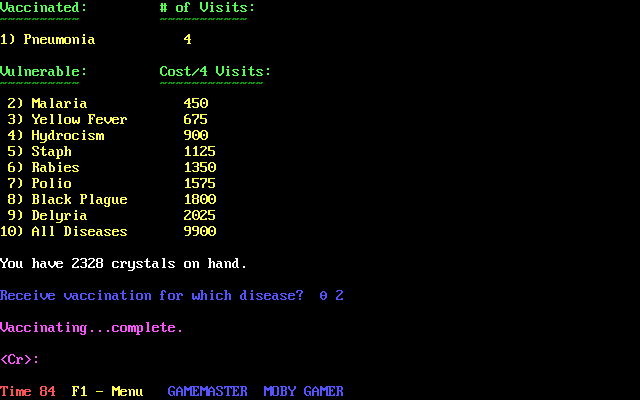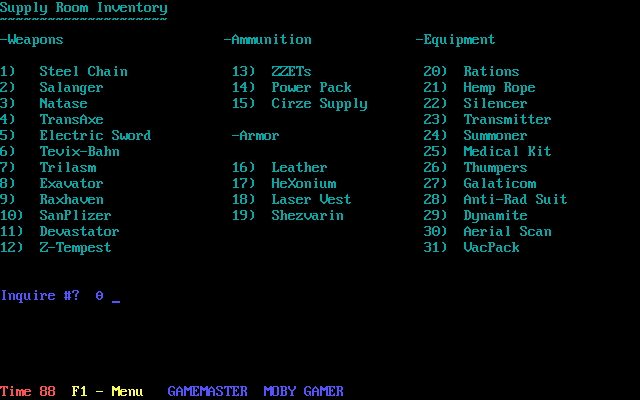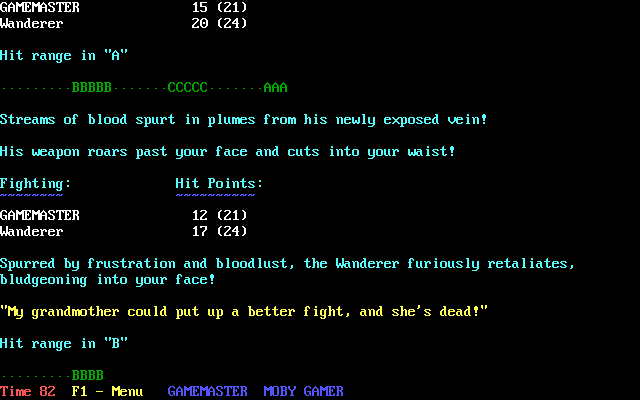Retro Replay Review
Gameplay
Operation: Overkill II delivers a refreshingly unconventional gameplay experience that relies entirely on text descriptions and colored ASCII symbols. At its core, the game blends exploration, resource management, and intense reflex-based combat. As an HX-909 soldier in the HeXonium Force, you must probe irradiated ruins and mutated wastelands in search of precious water crystals, making each expedition a tense and strategic affair.
The combat system escalates the tension with its countdown mechanic. Whether you’re lining up a long-range energy blast or engaging in brutal melee skirmishes, success depends on hitting the space bar at the precise moment. Faster countdowns for tougher targets ratchet up the challenge, and players with slow modem connections will appreciate the dedicated ANSI terminal option, which shifts most data and digitized sound to the client side for smoother encounters.
Beyond combat, the game weaves in survival elements that keep you on edge. You must monitor your radiation exposure, track dwindling supplies of protective gear, and manage the fragile integrity of your water crystals. Every decision feels weighty—do you venture deeper into a mutant-infested tunnel for a chance at rare crystals, or return to Zzexlia’s safety to regroup?
The pacing is deliberate yet urgent. Between scavenging runs, you’ll upgrade your weapons, fine-tune your reflex timing, and decode cryptic logs that hint at General Overkill’s whereabouts. Each successful mission hardens you for the next, turning Operation: Overkill II into a pulse-pounding odyssey through a world hanging by a thread.
Graphics
While Operation: Overkill II eschews traditional graphics, its colored ASCII presentation packs a remarkable punch. Every corridor, crater, and irradiated ruin is mapped out in stark, minimalist symbols that force your imagination to fill in the horrors lurking just off-screen. The result is an immersive tableau that feels uniquely alive, even without polygons or sprites.
The ANSI terminal support is a standout feature, especially for those accustomed to dial-up modems of the era. By relocating digitized sound files and bulk data to the client machine, the developers reduced latency and eliminated irritating connection slowdowns. What you lose in flashy visuals, you more than regain in seamless responsiveness and audio feedback that punctuates your victories and setbacks.
Environmental hazards are vividly communicated through color shifts and ASCII icons. Toxic landfills glow sickly green, while mutant nests flicker with deep crimson symbols. This palette not only guides your strategic decisions—warning you of high-radiation zones or ambush points—but also strengthens the oppressive ambience of a world on the brink of collapse.
Although modern gamers may scoff at text-based interfaces, the graphical style here feels intentional rather than limited. Operation: Overkill II turns simplicity into an asset, delivering clarity in navigation and an unfiltered, gritty aesthetic that complements its post-apocalyptic setting.
Story
The narrative backdrop of Operation: Overkill II is as bleak as it is compelling. Generations of industrial contamination have tainted Earth’s water supply, forcing survivors to convert the last pure reserves into stable water crystals. When the extraterrestrial Hydrites—led by the ruthless General Overkill—invade to seize these crystals, humanity’s defenses crumble, leaving behind radioactive wastelands rife with disease and abomination.
Set in 2060 AD, the story thrusts you into the boots of HX-909, a soldier stationed at Zzexlia, the HeXonium Force’s final stronghold. From this battered compound you launch perilous missions across derelict air bases, overgrown sewer tunnels, and mutant-infested graveyards. Each expedition uncovers fragments of the world’s downfall, from corrupted city archives to the personal journals of fallen comrades.
The writing excels at evoking a sense of urgency and despair. Sparse descriptions of ruined highways and rotting tunnels amplify the stakes of your quest for water crystals, while brief, horrifying glimpses of Hydrite war machines and rampant mutant hives remind you why failure is not an option. The gradual revelation of General Overkill’s possible return keeps a tight narrative tension, fueling your drive to reclaim Earth’s future.
In an era when many games rushed to fill screens with cinematic cutscenes, Operation: Overkill II leans on its prose and player imagination. The result is a haunting, cohesive storyline that feels both epic in scope and intimately personal in its portrayal of survival against impossible odds.
Overall Experience
Operation: Overkill II stands as a testament to the power of minimalism and strong design vision. Though it lacks the graphical bells and whistles of contemporary titles, it compensates with razor-sharp writing, innovative mechanics, and a relentless atmosphere. Every encounter, from racetrack-speed countdown duels to slow-burning exploration sequences, keeps you fully engaged in the struggle for Earth’s salvation.
The sense of progression is deeply satisfying. As you master the timing of reflex-based combat and amass a stockpile of water crystals, the game rewards your growing expertise with access to new zones, tougher adversaries, and poignant story revelations. Moments of triumph—the successful purge of a mutant nest or the recovery of a rare crystal cache—feel genuinely earned.
Technical considerations, like the ANSI terminal option and client-side audio, demonstrate a thoughtful approach to player experience during the era of dial-up networking. These measures ensure that the core gameplay remains smooth, even when the battlefield itself is fraught with environmental peril.
For gamers seeking an atmospheric, text-driven adventure with real stakes and challenging reflex-based combat, Operation: Overkill II is a standout title. Its unique blend of ASCII graphics, tense resource management, and immersive storytelling forms a cohesive package that still resonates with those who appreciate depth and atmosphere over flashy visuals.
 Retro Replay Retro Replay gaming reviews, news, emulation, geek stuff and more!
Retro Replay Retro Replay gaming reviews, news, emulation, geek stuff and more!









Reviews
There are no reviews yet.